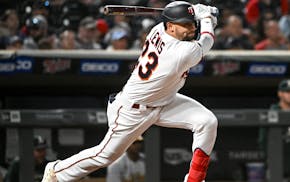The Twins smashed an MLB-record 307 home runs last season, making it obvious what needed to happen this offseason if they were to improve on their overall fate coming off a 101-win season but quick playoff exit: improve their pitching.
So of course their marquee free agent signing was … a power-hitting third baseman to add to an already potent lineup?
Yes, in some ways the Josh Donaldson signing feels like an expensive luxury item — a $92 million commitment on the wrong side.
But then you add up the plus side of the ledger and it's overwhelming. It's never a bad thing to add to a strength, nor is there a guarantee some of the Twins hitters who soared last year won't regress this season. Donaldson is insurance against that.
He's a perception-changing signing, one that should at least keep the "Cheap Pohlad!" (or more likely "Cheep Pohland") crowd at bay for at least a few news cycles.
And most of all, aside from Phil Miller's clever story start about Twins pitchers gaining by not having to face the Twin-killing Donaldson at the plate any more, Donaldson's greatest value to this team might end up coming on the defense/pitching side of the ball anyway.
The Twins had a bad defensive infield last season — an underrated but notable deficiency on an otherwise very good team.
One excellent metric for assessing this is defensive runs saved, a complicated but useful formula that essentially boils down to how much better or worse you are at preventing runs than an average fielder.
At every infield position last season, the Twins were on the minus side of the ledger and were in the bottom half of the league: third base (minus-1), shortstop (minus-5), second base (minus-6) and first base (minus-3) for a total of minus-15. Of particular note: Miguel Sano contributed a minus-5 at third base to that overall minus-1 number at third.
Donaldson with the Braves was a plus-15 at third base, second-best in the majors at his position. Just by himself last season he would have made the Twins an adequate fielding infield and was 20 runs saved better than Sano at third.
What does 20 runs look like? Well, if we were talking about a pitcher it would be about the difference between Kyle Gibson (86 earned runs allowed in 160 innings) and Jake Odorizzi (62 earned runs allowed in 159 innings).
Donaldson also started 32 double plays at third base last season. Twins third basemen combined to start 23. Saving runs and converting outs will be a huge boon to the Twins and a pitching staff that grew accustomed to such things in the outfield (plus-12 defensive runs saved, eighth-best in MLB) last season but not on the infield.
The rest of the 2020 infield defense remains shaky. Jorge Polanco is functional but below average at shortstop, making up for those shortcomings with excellent offense. Same goes for Luis Arraez (minus-8 in defensive runs at second base last season), who figures to take over that spot full time. Sano's deficiencies can be hidden more at first base, but he won't win a Gold Glove anytime soon.
Donaldson, 34, who had three other double-digit defensive runs saved seasons from 2013-15, at least gives the infield an anchor.
He'll also crank a lot of useful bombas, but that defense could be the thing that makes the biggest difference.
McCutchen leads off with home run for second day in row and Pirates beat Brewers 2-1
Kawhi Leonard is returning to the Clippers' lineup for Game 2 against Luka Doncic and the Mavericks
José Ramírez homers as Guardians continue scorching start with 4-1 win over Red Sox

